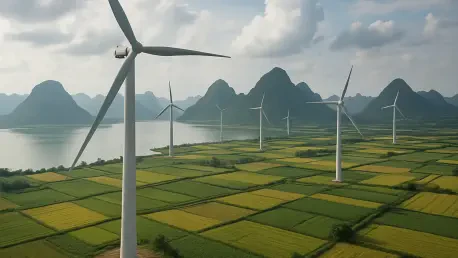In a world increasingly desperate for sustainable energy solutions, China has emerged as a powerhouse in the renewable sector, particularly through its ambitious strides in wind power technology. A recent groundbreaking initiative has captured global attention, spotlighting the nation’s determination to redefine the future of clean energy. With massive investments and innovative projects, China is not just addressing its own energy needs but also setting a benchmark for the rest of the world. This bold push is epitomized by the development of a colossal test site in Yingkou, a coastal industrial city in northeast China, where cutting-edge offshore wind turbines are being designed and validated. This facility, spearheaded by one of the country’s largest power developers, Huaneng, symbolizes a significant leap toward achieving energy independence and combating environmental degradation. As the global community watches, China’s efforts could inspire a ripple effect, encouraging other nations to accelerate their own renewable energy agendas.
Pioneering Massive Wind Turbine Technology
China’s latest venture into wind power is marked by an unprecedented focus on scaling up turbine technology to new heights. The Yingkou test site is specifically engineered to support the testing of a future 35-megawatt offshore wind turbine, a feat that pushes the boundaries of current engineering capabilities. This facility is equipped with essential infrastructure, including a robust foundation, a lifting platform, and dedicated worker facilities, all designed to facilitate the development of these massive turbines. Such a project goes beyond mere experimentation; it lays the groundwork for transformative advancements in the wind energy sector. By prioritizing larger and more efficient turbines, China aims to maximize energy output while minimizing the spatial footprint of wind farms. This strategic approach not only addresses domestic energy demands but also positions the nation as a leader in innovative renewable solutions, potentially setting new industry standards worldwide.
The significance of this initiative cannot be overstated, as it reflects China’s commitment to overcoming technical challenges in wind power. Market analysts have noted that the pursuit of a 35-megawatt turbine might not even represent the upper limit of what the country aspires to achieve. The Yingkou site serves as a testing ground for future innovations, ensuring that each advancement is rigorously validated before deployment. This meticulous process underscores a broader vision of enhancing turbine efficiency and durability, particularly in harsh offshore environments. By investing heavily in research and development, China is creating a platform that could redefine how wind energy is harnessed globally. The implications of these efforts extend far beyond national borders, offering a glimpse into a future where renewable energy becomes more accessible and cost-effective for all, driven by technological breakthroughs initiated in this coastal city.
Transforming the Global Energy Landscape
China’s wind power initiatives carry profound implications for both environmental sustainability and economic growth on a global scale. Historically one of the world’s largest polluters, the nation is now making a pivotal shift toward rectifying past damage through projects like the Yingkou test site. A single 35-megawatt turbine promises a multitude of benefits, from significantly lowering energy costs to stabilizing regional electrical grids. Additionally, this development fosters energy independence by reducing reliance on fossil fuels, a critical step toward cleaner air and safer living conditions for local communities. Beyond environmental gains, the project is expected to generate numerous job opportunities in manufacturing, engineering, and maintenance, boosting local economies. This multifaceted impact highlights how renewable energy can serve as a catalyst for broader societal improvements, aligning with international sustainability goals.
The ripple effects of China’s wind power ambitions are poised to inspire a worldwide movement toward renewable energy adoption. As other nations observe the tangible benefits of such large-scale projects, there is potential for a surge in global investment in wind farms and turbine technology. This trend could amplify both environmental and economic advantages, creating a more interconnected and sustainable energy future. China’s role as a frontrunner in this space is not merely about meeting domestic needs but also about demonstrating the viability of ambitious renewable energy strategies. By showcasing the success of initiatives like the Yingkou facility, the country is paving the way for collaborative international efforts to combat climate change. This leadership position could encourage policy shifts and technological exchanges, fostering a collective push toward a greener planet where wind power plays a central role in energy production.
Shaping a Sustainable Legacy
Reflecting on China’s bold steps in wind power, it’s evident that the efforts at Yingkou mark a turning point in the global fight against environmental degradation. The commitment to testing a 35-megawatt offshore turbine showcases a dedication to innovation that goes beyond immediate gains, aiming for lasting impact. This project, with its promise of reduced pollution and enhanced energy security, stands as a beacon of what is possible when technology and environmental responsibility converge. Looking ahead, the challenge lies in scaling these advancements, ensuring that the lessons learned are applied to future projects worldwide. Governments and industries should consider partnerships and knowledge-sharing to replicate such successes, focusing on policies that incentivize renewable energy investments. By building on this foundation, the global community can work toward a future where clean energy is not just an aspiration but a widespread reality, driven by the pioneering spirit exemplified in China’s remarkable endeavors.









